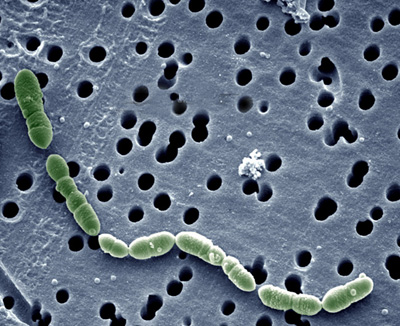|
|
 |
All who enjoy the taste of wine stand to benefit from the latest round
of genome sequencing at the U.S. Department of Energy's Joint Genome Institute.
JGI researchers have completed the sequencing of Oenococcus oeni,
a lactic-acid fermenting bacterium that plays a critical role in de-acidifying
wine after alcoholic fermentation has been completed.
|
|
 |
 |
|
|
 |
By fermenting lactic acid, Oenococcus
oeni plays a critical role in de-acidifying wine.
(photo courtesy of Jeff Broadbent and Utah State University) |
|
|
Most wine lovers know that yeast is used to ferment the sugar in the
grape "must" (the mixture of skins, pulp, seeds, and juice)
into alcohol. Less familiar is the need in many wines for a secondary
fermentation converting harsh-tasting malic acid into lactic acid, a much
softer-tasting acid so named for its presence in milk. Malolactic fermentation
contributes to flavor, aroma, and texture. For some wines, it can play
a role in spoilage and taint.
The yeast species most commonly used in the primary fermentation of wine,
Saccharomyces cerevisiae, does not metabolize malic acid. In many
wines, the malolactic fermentation will be carried out spontaneously by
lactic acid bacteria, in particular, Oenococcus oeni, which is
unusually tolerant of the wine's acid and ethanol concentrations. However,
this species of bacteria grows slowly, and if the malolactic fermentation
process is not timed to start immediately after the alcohol fermentation,
its performance can be sluggish.
|
|

|
 |
|
|
UC Davis professor David Mills is
coleader of the Lactic Acid Bacteria Genome Consortium, which worked
with the Joint Genome Institute to sequence the genome of Oenococcus
oeni
under the U.S. Department of Energy's Microbial Genome Program.
|
|
|
|
"Sequencing the genome of Oenococcus oeni will impact the
wine industry for many years to come," says David Mills, a viticulture
and enology professor at the University of California at Davis. "Moreover,
access to the aggregate sequences will completely alter the scientific
perspective on lactic acid bacteria."
Mills is coleader, along with Utah State University professor Bart Weimer,
of a nationwide, multi-institute scientific collaboration called the Lactic
Acid Bacteria Genome Consortium (LABGC). Through the consortium, Mills
and Weimer developed a proposal for the Oenococcus oeni genome
to be sequenced at JGI under the U.S. Department of Energy's Microbial
Genome Program.
"Our goal is to use this sequence to advance genomic study on the
lactic acid bacteria and other food fermentation microbes," says
Mills. "We want to gain a more comprehensive understanding of the
microbes' genetics and physiology, particularly in relation to their role
in fermented foods and beverages. We also want to identify and enhance
the beneficial roles of these bacteria in food preservation and safety,
and in the health of humans and animals."
JGI is a collaboration of Lawrence Berkeley, Lawrence Livermore, and
Los Alamos National Laboratories, funded by DOE's Office of Biological
and Environmental Research. Its headquarters in Walnut Creek, California,
houses one of the nation's fastest and most powerful genome sequencing
operations. JGI researchers completed their sequencing of the Oenococcus
oeni genome within a year.
"Straight sequencing of an individual microbe can be done in a day
with our capacity here," explains Kristen Kadner, a biologist with
Berkeley Lab's Genomics Division who helped coordinate JGI's lactic acid
bacteria effort. "However, the process is stretched out and spaced
between other types of microbes in order to help prevent contamination.
Once the initial sequencing phase is complete, we pass the data through
a preliminary quality control analysis before the rest of the genome is
taken to full 10-X sequencing," meaning that each genome is sequenced
a total of 10 times to minimize error rate and maximize the quality of
the data.
Mills expects JGI's completion of the Oenococcus oeni genome sequence
to be comparable to the completion of the genome sequence for yeast in
1996 in terms of beneficial impact. The data should help scientists gain
a better understanding of malolactic fermentation and the interactions
between lactic acid bacteria and yeast. This in turn should not only boost
scientific efforts to improve wine quality, but should also benefit dairy
fermentations and the burgeoning field of probiotics -- improving human
health and immunity through the ingesting of certain bacteria.
|
|
 |
 |
|
|
 |
California wine is the state's number
one agricultural product in retail value, with an estimated annual
economic impact of $33 billion in wages, revenues and economic activity,
according to a study commissioned by the Wine Institute and the California
Association of Winegrape Growers. |
|
|
JGI sequencing data is available to the public with no restrictions.
Mills and his UC Davis research group will fill in any gaps in the JGI-generated
sequence of the Oenococcus oeni genome with funding from the American
Vineyard Foundation and the California Competitive Grants Program for
Research in Viticulture and Enology.
"With this genetic roadmap in hand, the ability of scientists to
study the genetics, ecology and physiology of lactic acid bacteria in
wine and other fermented products will be amplified tremendously,"
Mills says.
Additional information:
|

